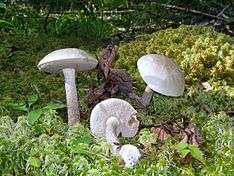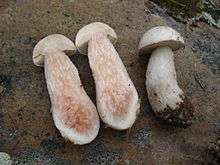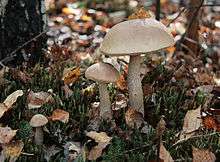Leccinum holopus
Leccinum holopus, commonly known as the white birch bolete, white bog bolete, or ghost bolete, is a species of bolete fungus in the family Boletaceae found in northern Asia, Europe, and northeastern North America. It associates with birch trees and is typically found in boggy or swampy areas, often growing among sphagnum moss.
| Leccinum holopus | |
|---|---|
 | |
| Scientific classification | |
| Kingdom: | |
| Division: | |
| Class: | |
| Order: | |
| Family: | |
| Genus: | |
| Species: | L. holopus |
| Binomial name | |
| Leccinum holopus | |
| Synonyms[1] | |
| |
| Leccinum holopus | |
|---|---|
float | |
| pores on hymenium | |
| cap is convex or depressed | |
| stipe is bare | |
| spore print is brown | |
| ecology is mycorrhizal | |
| edibility: edible | |
Fruitbodies (mushrooms) of L. holopus have convex caps measuring up to 10 cm (4 in) in diameter. Often pure white—especially in young fruitbodies—the caps sometimes become flushed with buff or brownish tints. The whitish surface of the stipe is covered with small, stiff, projecting scales (scabers) that become tan or darker in age. Some varieties of Leccinum holopus have been described that vary in cap color or staining reaction, but DNA evidence suggests that most are the same taxon. Although the fruitbodies are edible, opinions vary as to their culinary desirability.
Taxonomy
Initially named as a species of Boletus by German mycologist Friedrich Rostkovius in 1844,[2] the fungus was later transferred to Leccinum by Roy Watling in 1960.[3] Synonyms resulting from transfer to different genera include: Krombholzia holopoda and K. holopus (both published by Albert Pilát in 1951);[4] Krombholziella holopus (Josef Šutara, 1989);[5] Trachypus holopus (Paul Konrad and André Maublanc, 1952),[6] and Trachypus scaber f. holopus (Henri Romagnesi, 1939).[1] Other synonyms, according to Index Fungorum,[7] include Leccinum olivaceosum, described from France in 1994,[8] and Leccinum aerugineum (1991).[9] Leccinum holopus is classified in section Scabra of genus Leccinum, a grouping that includes Northern Hemisphere species associating exclusively with birch.[10]
The specific epithet holopus is Greek for "with perfect stalk".[11] Common names given to the fungus include white birch bolete, white bog bolete,[12] and ghost bolete.[13]
Several subtaxa of Leccinum holopus have been described. In form aerugineum, described by Josef Šutara in 2009, the flesh discolors green after injury.[14] The variety americanum, described by Alexander H. Smith and Harry Delbert Thiers in 1971 from collections made in Michigan, injured flesh stains reddish.[15] Lannoy & Estadès described Leccinum nucatum in 1993,[16] a taxon that was later (2007) published as variety nucatum of L. holopus;[17] no molecular evidence was found supporting the existence of this as a distinct taxon,[18] and it is therefore placed into synonymy with L. holopus.[19] Leccinum holopus var. majus, described by Rolf Singer in 1966 (originally published by Singer as Krombholzia scabra f. majus),[20] is another historical variety without independent taxonomic significance.[21]
Description

Fruitbodies of Leccinum holopus have convex to flattened caps measuring 3–10 cm (1.2–3.9 in) in diameter, with a narrow band of sterile tissue surrounding the margin. The caps are initially whitish, but can develop gray, buff, tan, or pinkish tints during maturity; the color may also darken and become greenish with age.[12] The cap surface is initially covered with very fine hairs,[22] but later becomes more or less smooth, often with a sticky texture in age or in moist conditions. The flesh is white and lacks any distinct odor or taste; it can have either little or no bruising color reaction with injury,[12] or may become light pink in variety americanum.[23] On the cap underside is a porous surface comprising pores numbering 2 to 3 per millimeter, each of which is the end of a tube that extends to 2.5 cm (1.0 in) deep. The color of the pore surface ranges from whitish to grayish to dingy brown, and has little color reaction to injury, although it may discolor yellowish or brownish.[12] There is a depression where the pores meet the stipe.[24] The stipe measures 8–14 cm (3.1–5.5 in) long by 1–2 cm (0.4–0.8 in) wide. Its whitish surface is covered with scabers that darken in age to tan or darker.[12] The stipe base often stains bluish.[24]
Leccinum holopus produces a brown spore print. Spores are somewhat fusoid (spindle-shaped) and measure 14–20 by 5–6.5 µm.[12] The basidia (spore-bearing cells) are four-spored and measure 28.5–36.5 by 11.5–12.5 µm. Cystidia on the pores are flask-shaped (lageniform) to fusiform, and 39.0–45.5 by 7.5–9.0 µm, while those of the stipe (caulocystidia) are fusiform, club-shaped, or cylindrical, measuring 39.0–54.5 x 9.1–13.5 µm. There are no clamp connections present in the hyphae of L. holopus.[18] The cap cuticle is arranged in the form of a cutis—with hyphae that run parallel to the cap surface.[24]
Several chemical tests can be used to help verify an identification of L. holopus. A drop of ammonium hydroxide solution turns the cap cuticle a pinkish color, but has no reaction with the flesh. A drop of dilute potassium hydroxide (KOH) has no reaction on the cap surface, and either no reaction or a brownish reaction with the flesh. Application of iron (II) sulphate solution does not have a reaction on the cap surface, and either no reaction to slightly olive coloration on the flesh.[24]
Similar species
Leccinellum albellum is similar in appearance to L. holopus, but grows in association with oak and has a more southerly distribution.[25] L. scabrum is a widely distributed lookalike that can be distinguished from L. holopus by its larger size and generally darker colors.[26]
Edibility
Although commonly considered edible, opinions vary on the culinary appeal of Leccinum holopus fruitbodies. Michael Kuo, writing in 100 Edible Mushrooms, considers it a good edible;[27] Peter Roberts and Shelley Evans in The Book of Fungi say "it is edible, but is said to be tasteless and pappy, so is not recommended."[28] Fruitbodies are optimally harvested when they are young, before the flesh becomes too spongy, and before insect larvae establish themselves. Minimal cleaning is required in the field. The mushroom has a mild, somewhat sweet flavor that is enhanced after brief sauteeing. Drying the mushrooms enhances the flavor, but diminishes the sweetness of fresh mushrooms.[27]
Habitat and distribution

Leccinum holopus is a mycorrhizal species.[29] It fruits on the ground (often among Sphagnum moss), singly to scattered in wet areas like cedar swamps, bogs, or soggy forests. Like most Leccinum species,[30] the fungus is highly host-specific and associates with birch (Betula). In North America, the range of Leccinum holopus extends from eastern Canada to New York, extending west to the northern Rocky Mountains, roughly coinciding with the distribution of the paper birch (Betula papyrifera). In this range, it is common and fruits from August to October.[12] L. holopus var. americanum is known only from North America.[28] The fungus is rare in southern Europe, but more common in the Sphagnum swamps in the north.[31] In Asia, it has been recorded from Taiwan and Qinghai (China).[32]
Fruitbodies of L. holopus are a source of food for fly species such as Pegomya winthemi (family Anthomyiidae) and Megaelia pygmaeoides (family Phoridae).[33]
References
- "Leccinum holopus (Rostk.) Watling". MycoBank. International Mycological Association. Retrieved 2015-01-17.
- Rostkovius FWT. Deutschlands Flora, Abt. III. Die Pilze Deutschlands (in German). 5-23/24. Nürnberg: Sturm. pp. 85–132 (see p. 131, t. 48.
- Watling R. (1960). "British records". Transactions of the British Mycological Society. 43: 692. doi:10.1016/s0007-1536(60)80061-7.
- Pilát A. (1951). Klíc urcování nasich hub hribovitých a bedlovitých (in Czech). Prague: Brázda. p. 65.
- Šutara J. (1982). "Nomenclatural problems concerning the generic name Krombholziella R. Maire". Česká Mykologie. 36 (2): 77–84.
- Konrad P, Maublanc A (1952). Les Agaricales 2: Russulacées, Hygrophoracées, Gomphidriacées, Paxillacées, Bolétacées. Encyclopédie Mycologique (in French). 20. Paris: Paul Lechevalier. p. 116.
- "GSD Species Synonymy: Leccinum holopus (Rostk.) Watling". Species Fungorum. CAB International. Retrieved 2015-01-17.
- Lannoy G, Estadès A (1994). "Contribution à l'étude du genre Leccinum S. F. Gray – 4 – Essai de clé monographique du genre Leccinum S. F. Gray". Documents Mycologiques (in French). 24: 1–29.
- Lannoy G, Estadès A (1991). "Contribution à l'étude du genre Leccinum S. F. Gray – 1 – Étude de L. variicolor, oxydabile et de quelques satellites, formes et variétés". Documents Mycologiques (in French). 21 (81): 11–26.
- den Bakker HC, Zuccarello GC, Kuyper TW, Noordeloos ME (2007). "Phylogeographic patterns in Leccinum sect. Scabra and the status of the arctic-alpine species L. rotundifoliae". Mycological Research. 111 (6): 663–72. doi:10.1016/j.mycres.2007.03.008. PMID 17604144.
- Schalkwijk-Barendsen HME. (1991). Mushrooms of Western Canada. Edmonton, Canada: Lone Pine Publishing. p. 201. ISBN 978-0-919433-47-2.
- Bessette AR, Bessette A, Roody WC (2000). North American Boletes: A Color Guide to the Fleshy Pored Mushrooms. Syracuse, New York: Syracuse University Press. p. 204. ISBN 978-0-8156-0588-1.
- Phillips R. (2013). Mushrooms: A Comprehensive Guide to Mushroom Identification. Basingstoke and Oxford, UK: Pan Macmillan. p. 290. ISBN 978-1-4472-6402-6.
- Šutara J, Mikšík M, Janda V (2009). Hřibovité Houby. Atlasy a Pruvodce (in Czech). Prague: Academia Nakladatelství. p. 38. ISBN 978-80-200-1717-8.
- Smith AH, Thiers HD (1971). The Boletes of Michigan. Ann Arbor, Michigan: University of Michigan Press. pp. 182–4.
- Lannoy G, Estadès A (1993). "Contribution à l'étude du genre Leccinum S. F. Gray – 3 – Étude de Leccinum nucatum sp. nov., Leccinum brunneogriseolum fo. chlorinum fo. nov. et L. molle avec comb. nov. de L. coloripes Blum". Documents Mycologiques (in French). 23 (89): 63–71.
- Klofac W. (2007). "Schlüssel zur Bestimmung von Frischfunden der europäischen Arten der Boletales mit röhrigem Hymenophor". Österreichische Zeitschrift für Pilzkunde (in German). 16: 187–279 (see p. 257).
- den Bakker HC, Noordeloos ME. (2009). "The genus Leccinum in Western and Central Europe". Retrieved 2015-01-18.
- "Record Details: Leccinum holopus var. nucatum (Lannoy & Estadès) Klofac". Index Fungorum. CAB International. Retrieved 2015-01-18.
- Singer R. (1966). Die Pilze Mitteleuropas, Band VI: Teil 2, Die Boletoideaea und Strobilomycetaceae (in German). Bad Heilbrun: Klinkhardt. p. 98.
- "Record Details: Leccinum holopus var. majus (Singer) Singer". Index Fungorum. CAB International. Retrieved 2015-01-18.
- Jordan M. (2004). The Encyclopedia of Fungi of Britain and Europe. London, UK: Frances Lincoln. p. 341. ISBN 978-0-7112-2378-3.
- Miller HR, Miller OK Jr (2006). North American Mushrooms: A Field Guide to Edible and Inedible Fungi. Guilford, Connecticut: Falcon Guides. p. 371. ISBN 978-0-7627-3109-1.
- Kuo M, Methven A (2014). Mushrooms of the Midwest. Urbana, Illinois: University of Illinois Press. p. 253. ISBN 978-0-252-07976-4.
- Binion D. (2008). Macrofungi Associated with Oaks of Eastern North America. Morgantown, West Virginia: West Virginia University Press. p. 165. ISBN 978-1-933202-36-5.
- McKnight VB, McKnight KH (1987). A Field Guide to Mushrooms: North America. Peterson Field Guides. Boston, Massachusetts: Houghton Mifflin. p. 112. ISBN 978-0-395-91090-0.
- Kuo M. (2007). 100 Edible Mushrooms. Ann Arbor, Michigan: The University of Michigan Press. pp. 185–6. ISBN 978-0-472-03126-9.
- Roberts P, Evans S (2011). The Book of Fungi. Chicago, Illinois: University of Chicago Press. p. 349. ISBN 978-0-226-72117-0.
- Kuo M. (April 2007). "Leccinum holopus". MushroomExpert.Com. Retrieved 2015-01-24.
- den Bakker HC, Zuccarello GC, Kuyper TW, Noordeloos ME (2004). "Evolution and host specificity in the ectomycorrhizal genus Leccinum". New Phytologist. 163 (1): 201–215. doi:10.1111/j.1469-8137.2004.01090.x.

- Kibby G. (2006). "Leccinum revisited: A new synoptic key to species" (PDF). Field Mycology. 7 (4): 77–87. doi:10.1016/S1468-1641(10)60573-7.
- Fu SZ, Wang QB, Yao YJ (2006). "An annotated checklist of Leccinum in China". Mycotaxon. 96: 47–50.
- Bruns T. (1984). "Insect mycophagy in the Boletales: Fungivore diversity and the mushroom habitat". In Wheeler Q, Blackwell M (eds.). Fungus-Insect Relationships: Perspectives in Ecology and Evolution. New York: Columbia University Press. pp. 91–129. ISBN 978-0-231-05694-6.
External links
| Wikimedia Commons has media related to Leccinum holopus. |